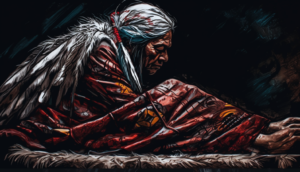According to traditional Navajo beliefs, a person’s chindi (spirit) leaves their body at death. Folklore suggests that this is because the individual failed to achieve world peace during their existence. The customs of the tribe also hint at the belief that coming into physical touch with a chindi can make one sick with ghost fever. The Navajo believe that the spirit of the dead can linger in material items belonging to the deceased, which are typically burned soon after death. Furthermore, the deceased’s name is never spoken after death for fear of bringing about the illness. For the chindi to scatter, it is customary to have deaths take place in the open.
A chindi is often depicted as a miniature dust devil. The Navajo refer to them as “dust devils,” They believe that a dust devil moving in a clockwise direction is a positive spirit, while one moving counterclockwise is an evil entity. Some Navajo speakers may refer to the Chindi as the Chi’idi, while others may spell it chdii.
The Navajo think that a person’s last breath contains all of their sins and that by releasing the Chindi into the world, it will eventually fade away. There is also the idea that witches and medicine men can infect others with the Chindi virus simply by being in the same room. In most cases, fever, fatigue, and nausea are the first indicators of ghost illness. The existence of a chindi or contact with a buried body part can also bring on this reaction.
The Navajo people continue to hold strong beliefs in the Chindi and perform ceremonies designed to protect them from its influence. Ghost beads, fashioned from cedar berries that have been hollowed out, are worn as amulets against the possession of evil spirits. They are typically produced by letting ants eat the berry’s insides, leaving behind a hollow shell punched and used to make necklaces and other jewellery. The different types of beads are also made of wood and used to ward off the chindi.






